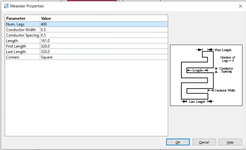danial314
Newbie

Hi everyone,
we are looking for inductance and capacitance of a meander with 400 legs. ( the exact parameters of the meander is bellow in the figure)
we placed the meander on the 500 um Si substrate and 500 um air on top. we run the simulation for S-parameters (S11) on sonnet and got resonance frequency 7.8GHz. Meander was defined to be lossless material in sonnet.
we tried to reproduce the s-parameter and inductance respectively in the HFSS and Maxwell both for the same Meander with perfect electric conductor but unfortunately our result are quite different. resonance is around 1GHz.
in SONNET: the inductance and capacitance that we extracted from the meander by fitting the data is around L=20 nH and C=22fF
in ANSYS Maxwell: the inductance and capacitance that we extracted from the meander by fitting the data is around L=170 nH and C=150fF.
What is the reason for this discrepancy?
we are looking for inductance and capacitance of a meander with 400 legs. ( the exact parameters of the meander is bellow in the figure)
we placed the meander on the 500 um Si substrate and 500 um air on top. we run the simulation for S-parameters (S11) on sonnet and got resonance frequency 7.8GHz. Meander was defined to be lossless material in sonnet.
we tried to reproduce the s-parameter and inductance respectively in the HFSS and Maxwell both for the same Meander with perfect electric conductor but unfortunately our result are quite different. resonance is around 1GHz.
in SONNET: the inductance and capacitance that we extracted from the meander by fitting the data is around L=20 nH and C=22fF
in ANSYS Maxwell: the inductance and capacitance that we extracted from the meander by fitting the data is around L=170 nH and C=150fF.
What is the reason for this discrepancy?


